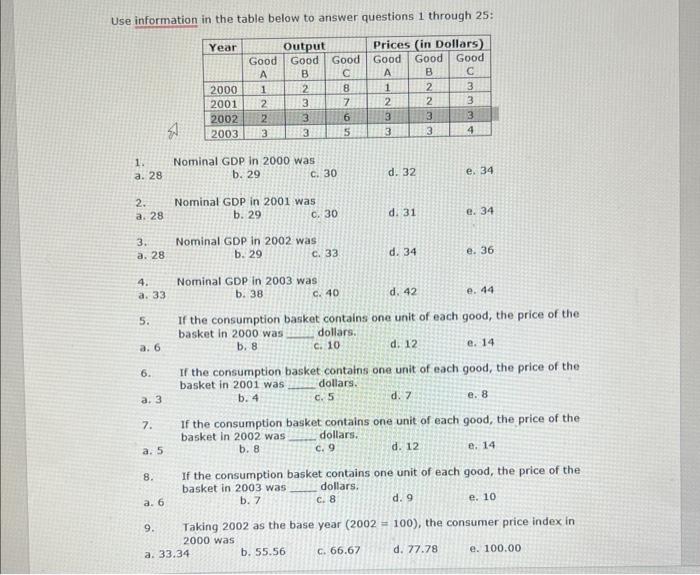Answered step by step
Verified Expert Solution
Question
1 Approved Answer
use the table below to answer questions 1 through 25. pls answer all questions until #37 :) Use information in the table below to answer





use the table below to answer questions 1 through 25.
Use information in the table below to answer questions 1 through 25: 1. Nominal GDP in 2000 was a. 28 b. 29 c. 30 d. 32 e. 34 2. Nominal GDP in 2001 was a. 28 b. 29 c. 30 d. 31 e. 34 3. Nominal GDP in 2002 was a. 28 b. 29 c. 33 d. 34 e. 36 4. Nominal GDP in 2003 was a. 33 b. 38 d. 42 e. 44 5. If the consumption basket contains one unit of each good, the price of the basket in 2000 was dollars. a. 6 b. 8 c. 10 d. 12 e. 14 6. If the consumption basket contains one unit of each good, the price of the basket in 2001 was a. 3 b. 4 dollars. d. 7 e. 8 7. If the consumption basket contains one unit of each good, the price of the basket in 2002 was a. 5 b. 8 dollars. d. 12 e. 14 8. If the consumption basket contains one unit of each good, the price of the basket in 2003 was a. 6 b. 7 dollars. d. 9 e. 10 9. Taking 2002 as the base year (2002=100), the consumer price index in 2000 was a. 33.34 b. 55.56 c. 66.67 d. 77.78 e. 100.00 10. Taking 2002 as the base year (2002=100), the consumer price index in 2001 was a. 33.34 b. 55.56 c. 66.67 d. 77.78 e. 100.00 11. Taking 2002 as the base year (2002=100 ), the consumer price index in 2002 was a. 33.34 b. 55.56 c. 66.67 d. 77.78 e. 100.00 12. Taking 2002 as the base year (2002=100), the consumer price index in 2003 was a. 100.00 b. 111.11 c. 121.21 d. 132.23 e. 143.34 13. Taking 2002 as the base year, real GDP in 2000 was a. 32 b. 33 c. 34 d. 35 e. 36 14. Taking 2002 as the base year, real GDP in 2001 was a. 32 b. 33 c. 34 d. 35 e. 36 15. Taking 2002 as the base year, real GDP in 2002 was a.32b.33c.34d.35 16. Taking 2002 as the base year, real GDP in 2003 was a.32b.33c.34d.35 17. Real GDP grew in 2001 at the rate of a. 9.09% b. 8.33% c. 0% d. 8.33% e. 9.09% 18. Real GDP grew in 2002 at the rate of a. 9.09% b. 8.33% c. 0% d. 8.33% e. 9.09% 19. Real GDP grew in 2003 the rate of a. 9.09% b. 8.33% c. 0% d. 8.33% e. 9.09% 20. In 2001 the economy went through a a. Expansion b. Recession c. Deficit d. a and c e. a and b 21. In 2002 the economy went through a a. Expansion b. Recession c. Deficit d. a and c e. a and b 22. Fiflation rate in 2001 was a. 11.11% b. 11.11% c. 16.67% d. 28.57% e. 37.2% 24. Inflation rate in 2003 was a.11.11%b.11.11%c.16.67%d.28.57%e.37.2% 25. Between 2001 and 2003 the economy experienced a. Deflation b. Inflation c. Appreciation d, a and b e. Depreciation 26. If the nominal interest rate in=8% and the expected rate of inflation r2= 4%, then the real interest rate L is a. 2% b. 3% c. 4% d. 5% e. 6% 27. If the nominal interest rate in =10% and the real interest rate ig = 5%, then the expected rate of inflation r2 is a. 2% b. 3% 4% d. 5% e. 6% 28. There are 130 million workers in the labor force; the unemployment rate is 5%. There are a. 3 b. 6.5 million of unemployed workers. d. 11.5 e. 45.6 29. There are 20 million workers in the labor force, 3 million are unemployed; the unemployment rate is a. 12% b. 13% c. 14% d. 15% e. 16% 30. There are 10 million unemployed in the economy; the unemployment rate is 20%. There are million workers in the labor force. a. 30 b. 40 c. 50 d. 60 e. 70 31. If 5 million unemployed in question 30 get discouraged and stop looking for work, the unemployment rate is. a. 2% b. 3% c. 4% d. 10% e. 11.11% 32. Let GDP =$11 trillion, C=$8 trillion, I=$1 trillion, G=$2 trillion and X =$2 trillion. The value of imports is $ trillion. a. 1 b. 2 c. 3 e. 5 33. Let GDP=$10 trillion, C=$7 trillion, I=$1 trillion, G=$2 trillion and M =$2 trillion. The value of exports is $ trillion. a. 1 b. 2 c. 3 e. 5 34. Inflation is defined as a. Increase in the price of commodities. b. Expansion of the consumer basket. c. Increase in price of assets. d. Increase in the price level. 35. Disinflation is a. Deflation. b. Particularly strong inflation. c. Decrease in the rate of inflation. d. None of the above is correct. 36. Deflation a. Helps the economy because consumers enjoy rising real wags. b. Helps the economy because companies have lower costs. c. Is harmful because it erodes profit of companies. d. Does not matter because money is neutral. 37. Let S=$2 trillion, I=$2 trillion, G=$3 trillion, T=$2 trillion and M=$2 trillion. The value of exports X is: trillion. a. $1 trillion. b. $0 trillion. c. $1 trillion. d. $2 trillion pls answer all questions until #37 :)
Step by Step Solution
There are 3 Steps involved in it
Step: 1

Get Instant Access to Expert-Tailored Solutions
See step-by-step solutions with expert insights and AI powered tools for academic success
Step: 2

Step: 3

Ace Your Homework with AI
Get the answers you need in no time with our AI-driven, step-by-step assistance
Get Started


